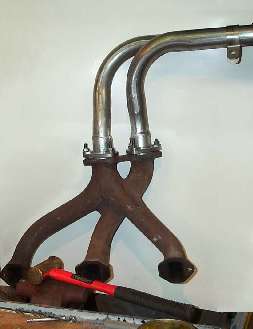
Chicagoland MG Club

Back to Archives
Submit an article
Cover
Intro & Club Officers
The Steering Column
The Passenger Seat
May Meeting Report
1st Annual Spring Tour
Spring Chicken Rally
Abingdon Summer Party
Abingdon Registration
MG Lola Getting Popular
Lands End Rally
Family Go-Kart Night
Miata/CMGC Autocross
"Flying Low" - The Rally
"Stand On It" Autocross
Regalia Items Available
Regalia Order Form
Camping Trip - The BRIC
The Rallye Corner
Message From Librarian
Just a Simple Wrench
Library Books List
Library Videos List
Classifieds
CMGC Events
Other Events
Back Cover
|
|

Just a Simple Wrench
by Ann & Jake Snyder
Almost Hot Enough
 Sooner or later, every MG owner/driver has to face replacing the exhaust system, unless it was replaced previously with a stainless steel unit. The regular steel types do not last as long as stainless steel systems (which do seem to be indestructible, barring mechanical damage), though the carbon steel variety cost only about half as much as stainless steel. But the problem with exhaust systems is less about the cost than about the ease of installation. They can be very simple in cases where all the nuts and bolts can be simply unscrewed, or they can be very frustrating. Take the case in point.
Sooner or later, every MG owner/driver has to face replacing the exhaust system, unless it was replaced previously with a stainless steel unit. The regular steel types do not last as long as stainless steel systems (which do seem to be indestructible, barring mechanical damage), though the carbon steel variety cost only about half as much as stainless steel. But the problem with exhaust systems is less about the cost than about the ease of installation. They can be very simple in cases where all the nuts and bolts can be simply unscrewed, or they can be very frustrating. Take the case in point.
All we wanted to do was unbolt the old one and put on the new one. Simple, except one manifold stud snapped. Considering that there are six studs on the twin-carb MGBs, that certainly was not as bad as it could have been. And the stud even broke off with a good quarter-inch length still exposed. A long time ago, we were faced with an identical problem that involved three broken studs. Unwilling to toss the manifold and search for a good used one or to replace it with a steel header, we took the worst approach and drilled the broken studs out. Never again! While we did get a usable exhaust manifold out of our efforts, the time spent was far out of proportion to the worth of the project. Then we took one of Mr. John Twist’s February Technical Session classes, and he removed stud after stud without effort. His secret was fire, in the form of an oxy-acetylene torch. He heated the manifold in the area of the stud to glowing-red and judiciously grasped the stud with a pair of Vise Grip pliers. And the stud unscrewed! His statement was that any length of time spent not breaking a bolt or stud is less time than will be needed to drill out a broken one.
|
So, while we should not have broken the stud in the first place, we were not going to compound the problem this time by drilling. And we decided to use a substitute for the oxy-acetylene torch, which was a bottle of MAPP gas that we had bought years ago. MAPP gas is a mixture of gases that are similar to acetylene, but which can be safely put into a propane torch bottle. Acetylene cannot be handled safely without the special absorbent that is in an acetylene cylinder, and may explode if compressed into a propane torch bottle. MAPP gas burns with a hotter flame than propane, though not nearly so hot as the combination of acetylene and oxygen. Of course, an initial investment of ten dollars for the MAPP cylinder (everyone already has a propane torch to use with it) compared to several hundred dollars for the oxy-acetylene gear and gas cylinders make the MAPP cylinder worth considering.
|

Heat about one inch around the stud until the manifold is cherry red. Do not heat the stud directly. Keep the MAPP flame moving.

After 10 minutes heating the manifold, the stud could be turned a little without twisting it off. It finally came out, intact. The missing stud on the left simply unscrewed without any problems, and was replaced with a new one.
|
So we tried removing the stud with the MAPP flame, and found that it was very slow work. It took at least 10 minutes to get the manifold glowing red around the stud, and we could not simply unscrew the broken stud with the pliers. The stud had to be rotated back and forth in the smallest of angles to get the extraction started. But the stud did not break off, and came out without causing any damage to the exhaust manifold.
|
We chased the thread in the manifold, as well as the threads on the remaining studs. The manifold studs are 5/16 inch diameter, coarse-threaded into the manifold, and fine-threaded to accept the nuts that hold the head pipe. The nuts should be brass or stainless steel to eliminate a repeat of the problem. We used lots of high-temperature anti-seize on all the threaded parts, though, with just a little luck, the stainless steel system will not have to be removed for a long time.
|

The new headpipe was assembled on the bench. The nuts are quite loose at this point. The new gaskets were installed with the steel shell against the manifold. The copper aligning tool was used gently to fit the studs through the holes in the flanges.
|
|





